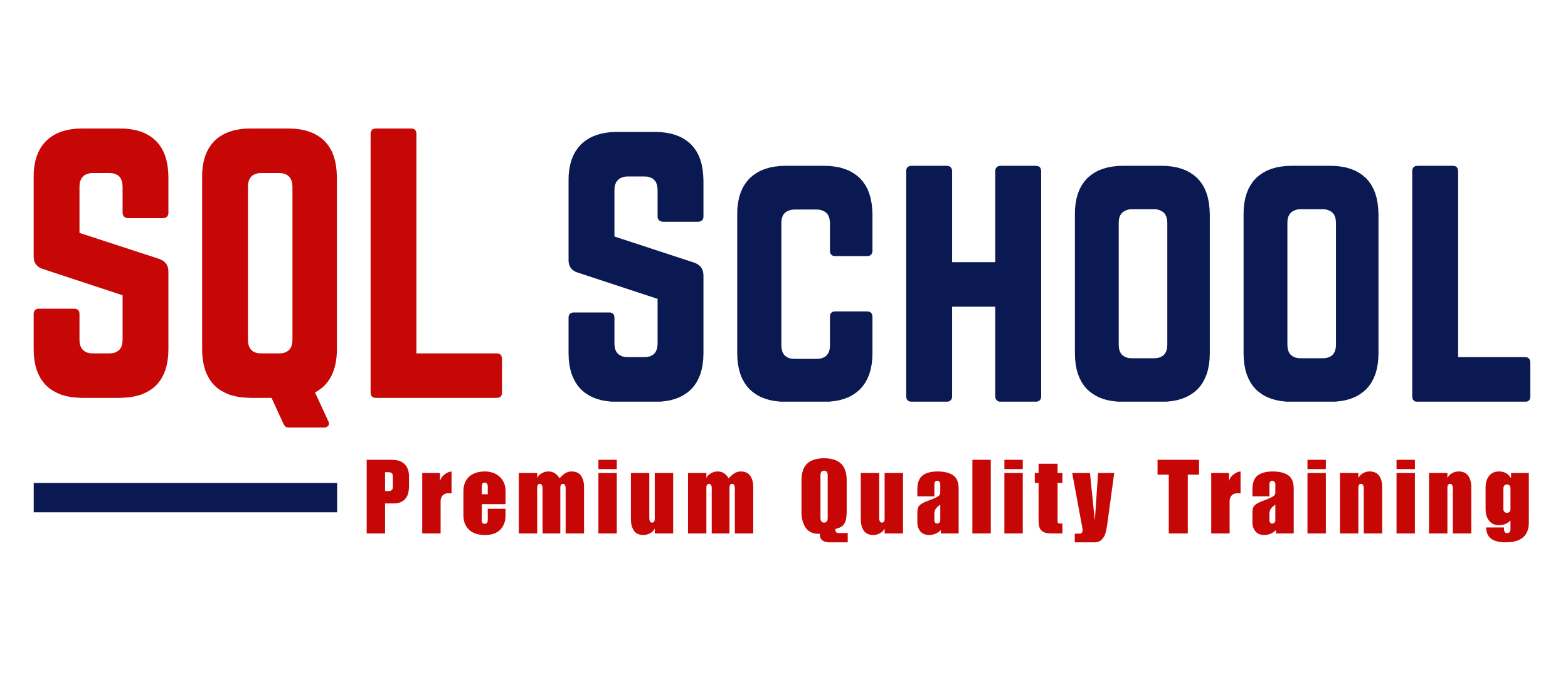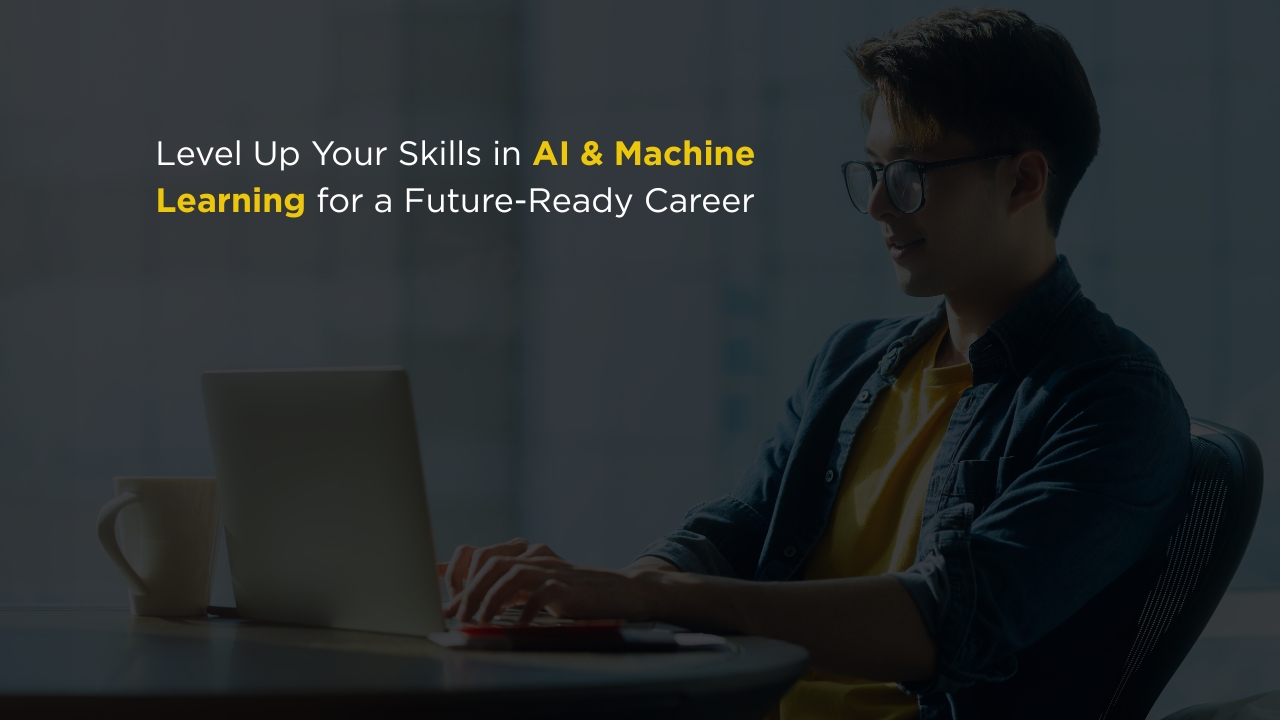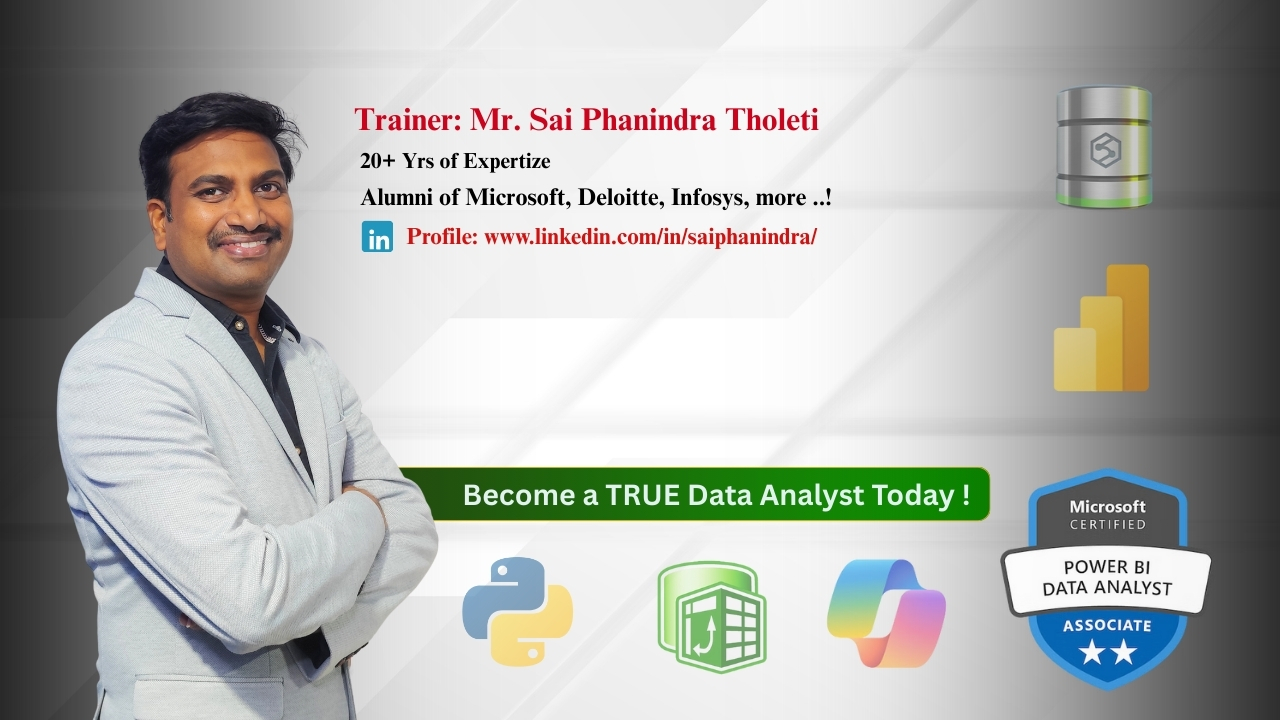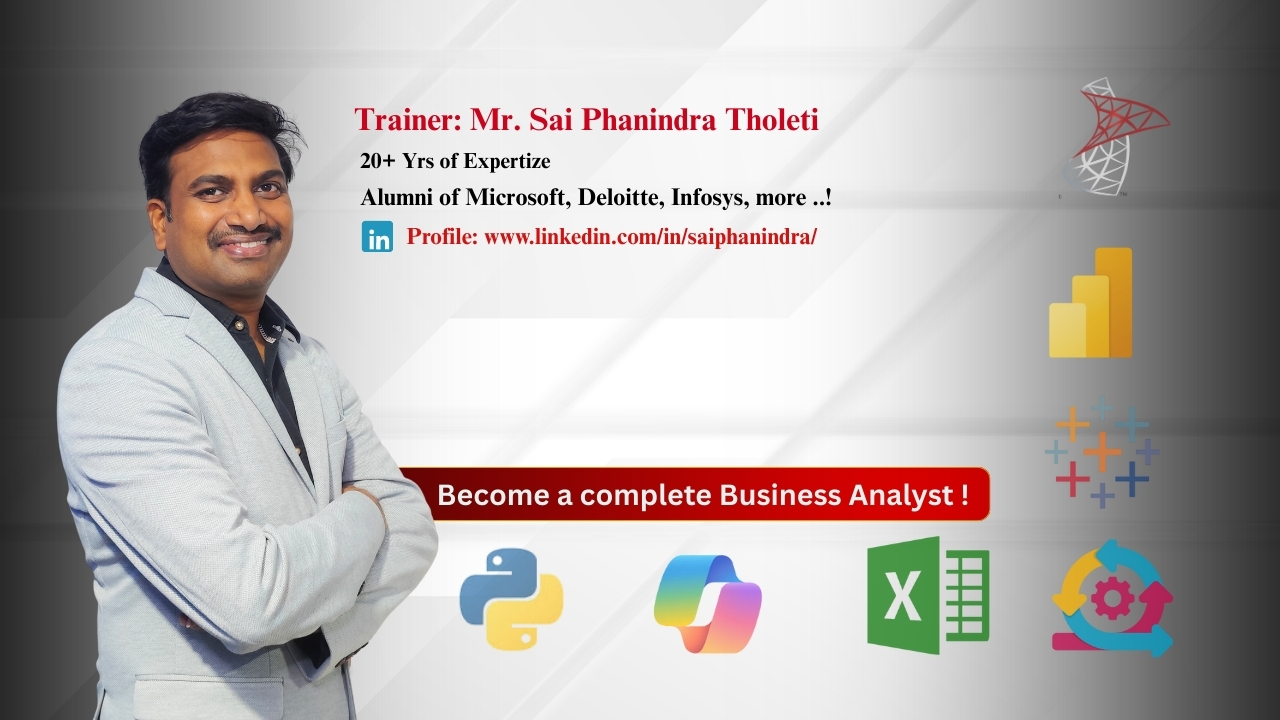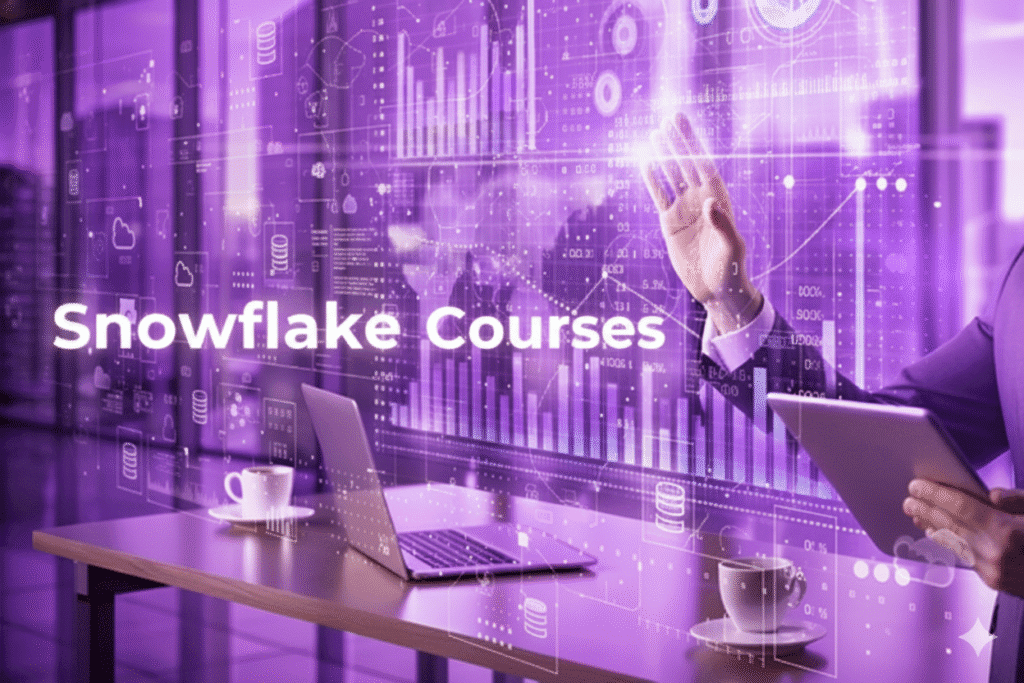No. Python is taught from the fundamentals — print statements, variables, operators, data types, lists, dictionaries, loops, and decision making.

Python is a versatile, beginner-friendly language used in software development, data analysis, AI, automation, and web apps. With powerful libraries like Pandas, Django, and TensorFlow, plus strong community support, mastering Python opens career opportunities in data science, AI, and full-stack development.
✅ Python Funda, PVM, Data Types
✅ Advanced Data Analytics with Python
✅ Pandas, NumPy for Data Wrangling
✅ API Integration & Data Automation
✅ Python for Data Visualization ()
✅ Matplotlib, Seaborn, Plotly
✅ Python Programming, Expressions
✅ Machine Learning with Python
✅ AI Integrations, ML Ops
✅ 1:1 Mentorship, Interview Guidance
Module 1 : Python Analytics
Ch 1: Python Introduction
- Python Introduction
- Python Versions
- Python Job Roles
- Python for Data Analysts
- Python for Data Engineers
- Python for Data Scientists
- Python for Data Science Engineers
Ch 2: Python Architecture
- Python Architecture
- PVM: Python Virtual Machine
- Compiler
- Byte Code
- Execution Process
- Resource Allocations
- Python Implementations
Ch 3: Python Installations
- Python Introduction
- Python Installations
- Anaconda Installation
- Python IDE & Usage
- Jupyter Notebooks
Ch 4: Python Print Statement
- Python Print Statement
- print(), print()
- Testing Case Sensitivity
- Single Line print()
- Multi Line print()
- print() with single quotations
- Debug with AI (AI Assistants)
Ch 5: Python Variables
- Python Variables
- Assigning values
- Purpose & Rules
- Variable Value Reads
- Multiple Variables & Print()
Ch 6: Python Operators
- Athematic *& Multiplier Operators
- Python String Literals
- Single, Double Quotes
- Format Strings (f string)
- Comparison, Indexing Operators
Ch 7: Python Data Types
- Python Data Types
- Integer, Float, String Data Types
- Type Casting
- Type Identification
- Multi Value Assignments
- Python Built-In Classes (data types)
Ch 8: Python Lists
- Creating Python Lists
- Printing List Items
- Print List Slices
- Length & Type
- list() method
- Empty Lists, Append
- Loops, List Updates
Ch 9: Python Dictionaries
- Python Dictionary
- Creating, Indexing Dictionaries
- Edit / Overwrite Key Values
- Lists inside Dictionaries
- Delete & Clear
Ch 10: Python Tuples
- Python Tuples
- Defining, Indexing
- Length(), Type()
- Mixed Values in Tuples
- Overwriting Tuples
- Tuple Class, (( ))
Ch 11: Python IF..ELSE Condition
- If..Else conditions
- if..elif..else & Shorthand if
- composite conditions
- Indent, pass statement
- in & negation operators
- range conditions
Ch 12: Python Loops (For)
- Python For Loop
- For Loop @ Range
- For Loop @ Sequence Values
- Nested Loops
- Loop Control Statements
- Break, Continue, Paas
Ch 13: Python Loops (While)
- While Loop
- Termination Checks (Expressions)
- Variables, Logical Conditions
- Loop Conditions, Operators
- Exit Conditions
- iter() and Looping Options
Ch 14: Python Dataframes
- Dataframes: Creation
- Pandas Dataframes
- Dataframes From Single List
- Dataframes from Dictionary
- Display Dataframes, List Items
- Identify, Replace Nulls, NumPy
Ch 15: Python SQL DB Access
- SQL DB Access with Python
- import pandas.DataFrame
- pyodbc module, sql functions
- SQL DB Cursor Connections
- SQL Query Executions: DDL, DML
- Filters, Aggregations with SQL
- Dataframe Usage with SQL
Ch 16: Dataframe Transformations – 1
- Dataframe Transformations
- Concat & Append
- Merge Function
- Join with Multiple Dataframes
- Indexing Operations
- Data Type Checks, Conversions
- Loops with Dataframes
Ch 17: Dataframe Transformations – 2
- Pandas – Cleaning Data
- Replace, Transform Columns
- Data Discovery & Column Fill
- Identify & Remove Duplicates
- dropna(), fillna() Functions
- Data Plotting & matlib Lib
Ch 18: Python Functions & Lambda
- Python Functions & Usage
- Function Parameters
- Default & List Parameters
- Python Lambda Functions
- Recursive Functions, Usage
- Return & Print @ Lamdba
Ch 19: Python File Handling
- File Handling, Activities
- Loop, Write, Close Files
- Appending, Overwriting
- import os, path.exists
- f.open, f.write
- f.read, f.close
Realtime Case Study (Banking / Finance) For Data Analysis
Module 2 : Python Programming
Ch 19: Python Modules
- Import Python Modules
- Built In Modules & dir
- datetime module in Python
- Date Objections Creation
- strftime Method & Usage
- imports & datetime.now()
Ch 20: Python User Inputs & TRY
- Try Except, Exception Handling
- Raise an exception method
- TypeError, Scripting in Python
- Python User Inputs
- Python Index Numbers
- input() & raw_input()
Ch 21: Python Dictionary
- Dictionary Creation, Use
- Hashing, Copy, Update
- Deletion, Sorting
- Len(), Inbuilt Functions
- Variable Types – python List
- Cmp() List Method
- Python Dictionary Str(dict)
- Programming Concepts
- Loops and Sets
- Realtime Usage
Ch 22: Python Packages
- Package in Python
- Creating a package
- Package Imports, Modules
- Sub Packages Creation
- Sub Package Imports
- Popular Packages in Python
- NumPy & SciPy
- Libraries in Python
- Python Seaborn
- Python framework
Ch 23: Exception Handling
- Shell Script Commands
- OS operations in Python
- File System Shell Methods
- os – math – cmd -csv – random
- Numpy (numerical python)
- Pandas – sys – Matplotlib;
- Common RunTime Errors
- Python Custom Exception;
- Exception Handling
Ch 24: Python Class & Objects
- Class variables, Instances
- Built in Class Attributes
- Objects – Constructors
- Modifiers – Self Variable
- Python Garbage Collections
- Hierarchical Inheritance
- Multilevel, Multiple, Hybrid
- Overloading & OverRiding
- Polymorphism – Abstraction
Ch 25: Regular Expressions
- Regular Expression
- Regular Expression Patterns
- Literals – Repetition Cases
- Groups andGrouping
- w+ and ^ , \s Expressions
- split function
- Regular expression methods
- match() in Regular Expr
- search(), re.findall for Text
Ch 26: Multi-Threading
- Python Multi-Threading
- Thread Synchronization
- Multiprocessing
- Python Gil & Programming
- Thread Control Block (TCB)
- Stack Pointers & App Usage
- Program Counters in Realtime
- Thread State Concept
- Python Exception Handling
Ch 27: Python TKinter
- Tkinter GUI Program
- Components & Events
- Adding Controls inTkinter
- Entry, Text Widgets
- Radio & Check Buttons
- Tkinter Forms in Realtime
- List Boxes, Menu, ComboBox
- Mainloop () & Functions
Ch 28: Python Web & IoT Intro
- Python Web Frameworks
- Django : Advantages
- Web Framework
- MVC and MVT – Django
- Web Pages using python
- HTML5, CSS3 usage
- PYTHON Bottle & Pyramid
- Falcon ; smart_open in python
Realtime Project on Banking / Finance
Module 3: Python with AI – ML
Ch 29: Machine Learning Basics
- Machine Learning Funda
- Python ML in Realtime
- Pandas Extension in ML
- Machine Learning Ops
- Business to Data Conversions
- ML Algorithms in Realtime
Ch 30: Python ML Concepts
- Machine Learning (ML) Intro
- Supervised, Unsupervised
- Scikit-Learn Library
- Python Libraries for ML
- sklearn : Advantages & Uses
- sklearn : Functions, Use
Ch 31: Python Data Handling
- Data structures
- Lists, Tuples, Sets
- Dictionaries,
- Pandas Data Operations
- Data Visualizations
- Matplotlib & Seaborn
Ch 32: AI With Python Intro
- Artificial Intelligence
- Applications of AI
- AI Applicative Uses
- AI Usage with Python
- AI – Python Environment
- Python Libraries
- AI with Python in Realtime
Ch 33: Supervised Learning
- Linear & Logistic Regression
- Decision Trees
- Random Forests
- Support Vector Machines
- Neural Networks Basics
- Linear Regression Steps
- Linear Regression in AI-ML
Ch 34: Unsupervised Learning – 1
- Clustering & K-means
- DBSCAN & Realtime Usage
- Dimensionality Reduction
- K clustering hierarchical
- DBScan : Realtime Uses
- KMeans clustering Vs DBSCAN?
- PCA Vs t-SNE
Ch 35: Unsupervised Learning 2
- Unsupervised Learning
- Concepts and Scope
- Realtime Usage
- Dimensionality Reduction
- Component Analysis (PCA)
- PCA: Concept & Usage
Ch 36: Generalized Models
- GLM Concept in Python
- GLM in Regression
- Considerations for GLM
- Problem Solving Skills
- Python Libraries
- Python Extensions: GLM
Ch 37: Python Tree Models
- Decision Tree Models
- Decision Tree Working
- Model Works, Algorithms
- Random Forest Concept
- Random Forest Tree
- Random Forest Vs Knn
Ch 38: Big Data and ML
- Spark and Big Data
- Big Data with Python
- Spark with Python
- Spark with Big Data
- Spark Algorithms
- AI ML Libraries
Ch 39: Natural Lang” Processing
- NLP : Purpose, Usage
- NLP Applicative Uses
- NLP Vs Machine Learning
- NLP in Machine Learning
- Using NLP in AI – ML
- NLP code in Python?
Ch 40: AI in Real-World
- AI in Chatbots
- AI in Virtual Assistants
- AI Ethical Considerations
- AI Deployments (Flask)
- AI with FastAPI
- AI with Streamlit
- End to End Project Work
- Python AI
- Python ML
- Realtime Project
- Resume Guidance
- 1:1 mentorship

What is the Python Training course?
This course teaches complete Python from basics to advanced including Python Concepts, Python Programming, Data Analytics, AI, Machine Learning, NLP, and real-time project development.
Who can join the Python course?
Anyone — freshers, non-IT learners, Data Analysts, Python Developers, Data Scientists, and professionals starting from scratch. The training begins from basics of data, databases, and analysis.
What are the Python Training Plans?
The course is carefully curated with below module:
Plan A: Python Concepts (Ch 1–18 | 4 Weeks)
Plan B: Python Concepts + Python Programming (Ch 1–28 | 6 Weeks)
Plan C: Python Concepts + Programming + Python AI–ML (Ch 1–40 | 9 Weeks)
What Python basics will I learn in this course?
Python versions, Python architecture, PVM, byte code, installation, Jupyter Notebooks, variables, operators, data types, lists, tuples, dictionaries, IF/ELSE, loops, and file handling.
Do you teach Data Analytics using Python?
Yes. Pandas DataFrames, null checks, merges, joins, transformations, cleaning, replacing, deduplication, type conversions, plotting, and NumPy usage are covered.
Will I learn SQL database access from Python?
Yes. pyodbc connections, SQL cursor operations, DDL/DML queries, aggregations, and Pandas + SQL integration are included.
Does the course include Python Functions & Lambda?
Yes. Function parameters, default arguments, lambda functions, recursive functions, and return behaviors are covered.
Do you cover Python File Handling?
Yes. File open, read, write, append, overwrite, OS path checks, loops with files, and text processing are included.
Is Python Programming included in this course?
Yes. Modules, built-in modules, date/time, exception handling, user inputs, directories, hashing, sorting, sets, packages, and Python frameworks.
Will I learn Object-Oriented Programming in Python?
Yes. Classes, objects, constructors, self variable, inheritance (single, multi-level, multiple, hierarchical, hybrid), method overriding, polymorphism, abstraction, and garbage collection.
Do you teach Regular Expressions?
Yes. Pattern matching, literal/repetition patterns, groups, meta-characters, match(), search(), split(), and regex-based text operations.
Is Multi-threading included?
Yes. Thread synchronization, GIL, TCB, program counter, loop handling, and exception handling for multithreaded programs.
Does the course include Python GUI Development?
Yes. Tkinter GUI forms, events, controls, buttons, list boxes, menu bars, combo boxes, and real-time Tkinter applications.
Will I learn Python for Web & IoT?
Yes. Python Web Frameworks such as Django, Bottle, Pyramid, Falcon, HTML5, CSS3 usage, and real-time Python web application basics.
Do you cover Machine Learning using Python?
Yes. Machine Learning fundamentals, algorithms, supervised & unsupervised learning, scikit-learn, regression, classification, clustering, dimensionality reduction, PCA, t-SNE, and GLM.
Is AI included in the Python course?
Yes. AI fundamentals, AI environments, AI with Python, AI libraries, real-time use cases, AI chatbots, virtual assistants, FastAPI, Flask, and Streamlit deployments.
Do you teach NLP (Natural Language Processing)?
Yes. NLP basics, text cleaning, tokenization, regex patterns, NLP vs ML, NLP usage in AI–ML, and NLP coding in Python.
Is there a real-time project included?
Yes. End-to-end Python AI, Python ML, and Data Analytics projects with practical datasets, resume guidance, and 1:1 mentorship.
What training modes are available?
Live Online Training, Self-Paced Videos, 1:1 mentorship, real-time labs, resume preparation, and mock interviews.
Placement Partners

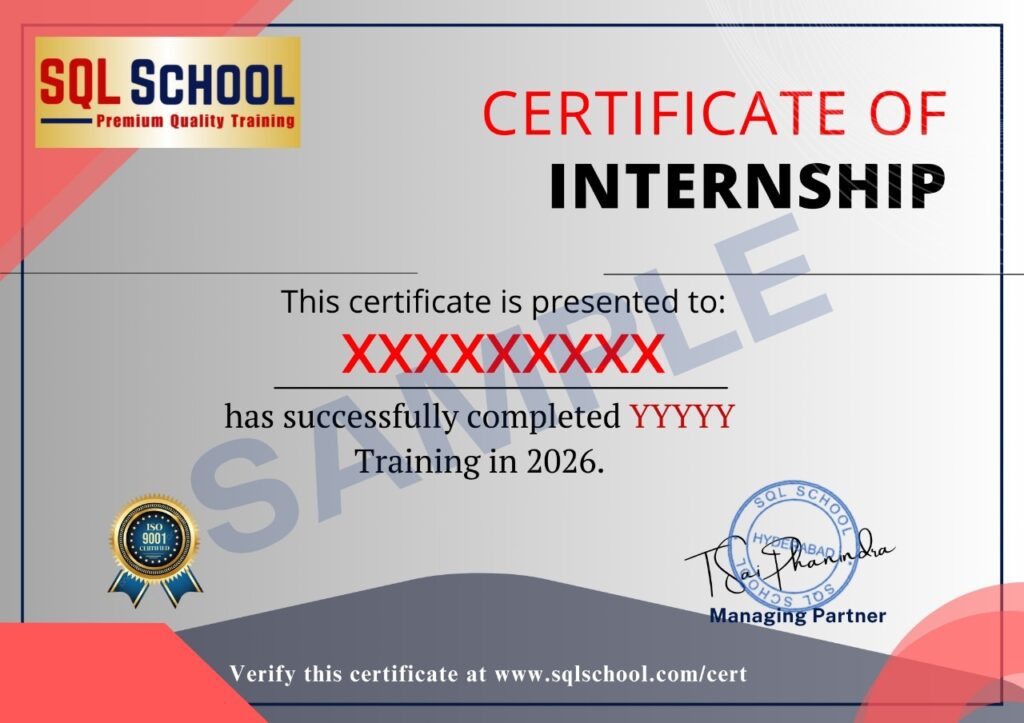
SQL SCHOOL
24x7 LIVE Online Server (Lab) with Real-time Databases.
Course includes ONE Real-time Project.
#Top Technologies
Why Choose SQL School
- 100% Real-Time and Practical
- ISO 9001:2008 Certified
- Weekly Mock Interviews
- 24/7 LIVE Server Access
- Realtime Project FAQs
- Course Completion Certificate
- Placement Assistance
- Job Support
